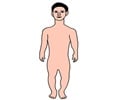- Covelli V1, Raggi A, Meucci P, Paganelli C, Leonardi M. Ageing of people with Down's syndrome: a systematic literature review from 2000 to 2014. Int J Rehabil Res. 2016 Mar;39(1):20-8.
- Wilson B, Jones KB, Weedon D, Bilder D. Care of Adults With Intellectual and Developmental Disabilities: Down Syndrome. FP Essent. 2015 Dec;439:20-5.
- Frances K. Wiseman, Kate A. Alford, Victor L.J. Tybulewicz and Elizabeth M.C. Fisher. Down syndrome—recent progress and future prospects. Human Molecular Genetics, 2009, Vol. 18, Review Issue 1 R75–R83.
- What conditions or disorders are commonly associated with Down syndrome? - (https://www.nichd.nih.gov/health/topics/down/conditioninfo/Pages/associated.aspx)
- Down Syndrome: Overview - (https://www.nichd.nih.gov/health/topics/down/Pages
/default.aspx) - About Down Syndrome - (http://www.globaldownsyndrome.org/about-down-syndrome/)
- Down Syndrome - (http://www.ndss.org/Down-Syndrome/)
- Overview -Down Syndrome - (https://medlineplus.gov/downsyndrome.html#cat95)
- Introduction About Down syndrome - (https://en.wikipedia.org/wiki/Down_syndrome)
- Know About Down Syndrome - (http://www.thearc.org/learn-about/down-syndrome)
- DADS - (http://www.ndss.org/PageFiles/2594/Aging%20and%20Down
%20Syndrome%20A%20Health%20and%20Well-Being%20Guidebook.pdf) - Learning About Down Syndrome - (http://www.dsaatl.org/)
- Aging and Down Syndrome - (https://www.genome.gov/19517824/learning-about
-down-syndrome)
What is Down Syndrome?
Down syndrome (DS) is a genetic disorder involving an extra copy of chromosome 21. Symptoms include intellectual disabilities and distinctive facial features.
Down syndrome was first described as early as 1866 by Langdon Down, a London-based physician. It is also known as 'Up syndrome' because of the cheerful persona of the children.

Down syndrome is the most common genetic cause of intellectual disability and is also credited to be one of the most common chromosomal abnormality among newborns.
Lejune and co-workers (1959) were the first to report the presence of an extra chromosome 21 (trisomy 21) in the cells of individuals with Down syndrome - a landmark in the field of congenital disorders in general and in the area of cytogenetics in particular.
Facts and Statistics of Down Syndrome
- The incidence of Down syndrome is estimated to be 1 in 1000 - 1100 live births worldwide.
- Yearly, 3000 to 5000 children are born with this syndrome worldwide.
- Hearing deficits occur in 60 - 80% of children with Down syndrome.
- Congenital heart diseases appear in around 40% of Down syndrome individuals contributing to the increased number of their deaths in infancy.
- With the help of advances in medicine and the rise in community support groups, 80% of Down syndrome patients reach their 50th birthday and beyond.
- It has been widely reported that Down syndrome children are more commonly born to older mothers - but in a country like India too, where women get married and produce children at an early age, this condition is equally prevalent as anywhere else in the world.
- Couples who already have a Down syndrome child have increased chances of recurrence compared to the general population.
What are the Causes and Types of Down Syndrome?
Down syndrome has a genetic basis, where the cells of the affected person have an extra chromosome 21. This may occur due to:
- The improper separation of chromosome 21 (non-disjunction). The cells of the human body have 23 pairs of chromosomes (46 chromosomes), while the reproductive cells, that is the egg and the sperm each have only one set of chromosomes i.e. 23 chromosomes. During the process of formation of these cells, if the separation of the pair of chromosome 21 does not happen properly, the reproductive cell could have an extra chromosome 21. When fertilization between the male and female reproductive cells takes place, the baby cells thus have 3 copies of chromosome 21 with a total number of 47 chromosomes. This is called trisomy 21 and accounts for 95% of Down syndrome cases. Several studies have associated non-disjunction with increased maternal age.
- Mosaicism or mosaic Down syndrome is diagnosed when there are two types of cells present in the body. Some cells have the normal number of chromosome 21, i.e. two, while some have 3 copies of chromosome 21. Therefore, the total number of chromosomes in the cell can be 47 or 46. Mosaicism is the least common type and occurs only in 1% of the population. The symptoms of Down syndrome are less severe than these cases.
- Translocation is another type of chromosomal abnormality in Down syndrome patients in which the number of chromosomes in each cell remains 46 but there is a full or partial extra copy of chromosome 21 that attaches itself onto chromosome 14. This can be inherited from the parents or it can arise de novo during embryo formation.

Over 95% of the Down syndrome cases result from classical trisomy 21 while the remaining 5% may exhibit mosaicism or translocations.
What are the Symptoms of Down Syndrome?
Down syndrome is a complex pathological condition with a range of physical, mental and biochemical changes.
Physical features and disease conditions affecting the individual include:
- Flat facial profile
- Small head at birth
- Up slanting eyes with skin fold over the inner corner
- White spots on the colored part of the eye
- Snub nose
- Protruding tongue
- Gum disease and dental problems
- Short ears
- Small chin
- Visual / auditory defects
- Congenital heart defects
- Deep ridge on the palm of the hand
- Gap between the first and second toes
- Decreased muscle tone (hypotonia)
- Short neck with loose skin on the posterior part of the neck
- Problem with the upper part of the spine called atlanto-axial instability
- Short /thick hands and feet
- Gastrointestinal malformations like poor development of the first part of the small bowel and blockage of the large intestine and with an inability to pass stool
- Gastroesophageal reflux disease
- Blood abnormalities with increased chances of developing lekuemia
- Reduced immunity with infections like pneumonia
- Reduced fertility in males
- Looseness of the hip joint
- Epilepsy
- Obstructive sleep apnea

Cognitive, Emotional and Behavioral Problems:
- Delayed developmental milestones
- Intellectual disability with Intelligence Quotient (IQ) lower than normal
- Short attention span
- Impulsive behavior
- Slow learning including delayed language and speech
- Anxiety
- Depression
- Attention deficit hyperactive disorder
- Repetitive movements
- Autism
- Aggression
- Psychosis
- Social withdrawal
- Dementia or Alzheimer’s / premature aging
- Disruptive sleep patterns
Biochemical Features:
- Thyroid dysfunction resulting in low thyroid hormone levels or hypothyroidism
- Over expression of enzymes such as superoxide dismutase
- Ammonia/uric acid accumulation
- Poor lipid metabolism
All the above features may not be present in one single individual but many of them, in various combinations will be present.
How is Down Syndrome Diagnosed?
Tests to diagnose Down syndrome include the following:
1. Prenatal Screening Tests: Prenatal screening tests are tests done before the baby is born, which show an increased likelihood of the baby suffering from the disease. These include:
- Combined Test: This includes two tests which are done in the first trimester - a blood test to measure levels of protein and an ultrasound called the nuchal translucency test that checks for abnormal levels of fluid behind the baby’s neck in the first trimester.
- Triple Screen or Quad Screen: These blood tests are done in the second trimester to check the levels of 3 or 4 proteins, respectively.
- Cell-free Fetal DNA: This is a blood test done on the mother to analyze DNA of the baby which is released in the maternal circulation.
2. Prenatal Diagnostic Tests: If there is a previous history of an affected baby, if a woman is over 35 years or if the screening test shows an increased likelihood of the syndrome, prenatal diagnostic tests are done. Diagnosis tests check for the presence of the extra chromosome. These tests could pose some risk to the mother and the baby which may include miscarriage.
- Amniocentesis can be done during 15-20 weeks of pregnancy. A small amount of amniotic fluid that surrounds the baby is drawn to carry out this prenatal study and the fetal cells are studied under a microscope.

- Chorionic villi sampling carried out during 9-14 weeks of pregnancy is done by taking a sample of cells from the placenta.
- Percutaneous umbilical blood sampling (PUBS) done later in pregnancy during the 18th to 22nd week takes a sample of fetal blood from the umbilical cord through the uterus.
- Cell-free fetal DNA can also be used as a prenatal diagnostic test.
3. Pre implantation Genetic Diagnosis (PGD) is another genetic technology that has revolutionized the choices available to prospective parents. Couples undergoing IVF treatment, whose baby is at risk for genetic abnormalities, can have their embryos analyzed with the help of specific probes. This detects chromosome imbalances or other genetic disorders in a fertilized egg before implanting the same in the uterus. This way the aberrant embryos are eliminated and only the viable ones are transferred back to the uterus.
4. At Birth: Down syndrome diagnosis can be confirmed by taking a blood sample of a baby at birth and by subjecting the same to a genetic test called ‘karyotyping’. This test helps to detect the extra chromosome 21 and also the translocations that lead to Down syndrome.
How is Down Syndrome Treated?
The management of Down syndrome depends on the extent of the condition. Though a complete cure is not possible, an early intervention starting from birth can improve the quality and duration of life of the affected child.
Some children might have a heart defect that has to be taken care of right after birth while some may have digestive issues that might need lifelong care.
Speech therapy and physical therapy can enhance the communicative ability and motor skills of the patients, respectively.
Assisted device is a type of material, equipment, tool or technology that will make the life of a person with Down syndrome easier. Amplification devices for hearing, special pencils to write, and touchscreen computers are some assisted devices that have helped these individuals.

Occupational therapy will help to identify jobs that suit the patients when they are older.
Emotional and behavioral therapy will help the children cope with emotions, interpersonal skills, compulsive behavior, and puberty issues.
Inclusive education helps in giving a fair education to these children in par with the general population.
Dementia and Alzheimer’s are common in Down syndrome individuals. Drugs to curb memory loss have not shown any benefit. Some patients take amino acid supplements that might aid in improving brain function.
The immediate family may well benefit from psychological and genetic counseling as the situation demands.
What is the Prognosis of Down Syndrome?
It is impossible to predict the life span of a Down child. If the Down individual has good access to medical and psychological help as well as financial assistance, there are chances of living longer compared to a Down syndrome individual with poor access. Several children with Down syndrome learn to read and write, and some have even graduated, have regular jobs and even live semi-independently.
Heart problems or infections put these individuals at a higher risk of early death. Currently however, thanks to improved health care, scientific technology and medications, the life expectancy of individuals with Down syndrome has increased to 50 to 60 years. However, compared to the general population, they do endure premature aging at around 45 years of age.













